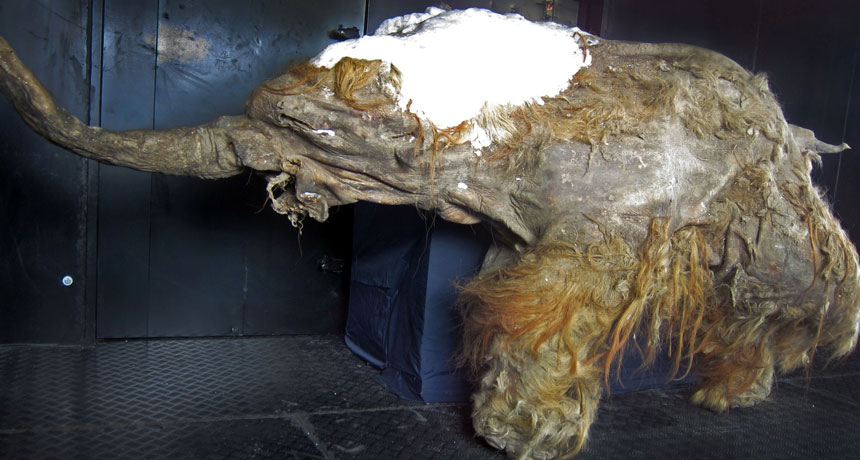
UNFROZEN Scientists in Japan found some mostly intact DNA-containing compartments called nuclei in the cells of this Siberian mammoth that was frozen for 28,000 years.
Cyclonaut/Wikimedia Commons (CC BY-SA 4.0)
- More than 2 years ago
Proteins from woolly mammoth cells frozen for 28,000 years in the Siberian tundra may still have some biological activity, claim researchers attempting to clone the extinct behemoths.
Japanese scientists first extracted nuclei, the DNA-containing compartments of cells, from the muscles of a juvenile woolly mammoth called Yuka, discovered in 2010 in northeast Russia. The team then transplanted those nuclei into mouse eggs and watched what happened next.
The mammoth cells did not come back to life to create a cloned mammoth, as researchers had hoped. But the cells did show some early signs that biological activity might be preserved for millennia, the researchers report in a paper published March 11 in Scientific Reports. Science News talked to Lawrence Smith to see if those claims really hold up. Smith, a geneticist and reproductive biologist at the University of Montreal Faculty of Veterinary Medicine who was not involved in the study, is an expert in cloning.
What exactly did the Japanese researchers find?
The study is part of an effort to clone a mammoth, Smith says. The scientists did similar work in 2015, but the new study presents evidence that the nuclei in the frozen animal’s cells still contained some important proteins, including some that spool DNA and others that form a scaffold that helps the nucleus keep its shape. To determine if those proteins could still do their jobs, Akira Iritani of Kindai University in Wakayama, Japan, and colleagues extracted 88 nuclei from muscle cells and transferred some to mouse oocytes, or eggs.
Within the mouse eggs, the mammoth nuclei began showing signs of preparing to make new cells — assembling structures called spindles that help divvy up DNA in dividing cells, compacting the DNA and forming “blebs,” or bubblelike structures in the membrane surrounding the DNA.
That’s evidence that the nuclei were still capable of some biological activity, even after 28,000 years, the researchers say.
But after those initial stirrings, the activity stopped. None of the mouse-mammoth hybrid cells divided to form new cells, probably because the mammoth DNA was too damaged. Usually, DNA is organized into chromosomes, each a long string of millions of chemical units, or base pairs, of genetic information. But in most of the frozen mammoth cells, the DNA had crumbled to bits only about 150 base pairs long. Some of the muscle cells had somewhat longer DNA stretches at more than 300 base pairs long.
Does this mean the mammoth cells were revived?
“It’s a bit of a far reach to say that they’ve woken up mammoth cells,” Smith says. “What they saw was mostly the [mouse] oocyte trying to do something with that DNA.” In fact, he says, there’s no clear evidence that the mammoth proteins were doing anything at all.
Usually during cloning experiments, researchers remove the egg’s chromosomes before putting in the nucleus from a mature cell. In this case, however, the eggs still had their own DNA and nuclear proteins. It’s those mouse proteins that probably caused the activity that the researchers noted, Smith says. In his opinion not much changed between the “before” images of mammoth-stuffed mouse eggs presented in the paper and the “after” pictures once the eggs got a chemical jump-start that simulates fertilization. “Maybe the nucleus swelled a bit, which may indicate there was some incorporation of proteins, but it’s not clear that did happen at all,” he says.
This experiment “doesn’t really confirm whether it’s the oocyte or the [mammoth] nucleus doing anything. I think a lot of other experiments need to be done to show whether [activity] is actually coming from the nucleus and not the oocyte,” he says.
Are mouse eggs good for cloning mammoths?
Eggs from closely related species may be able to support cloning, but mammoths and mice are evolutionarily distant relatives. “If we’re talking about mammoth and mouse, that’s part of the problem,” Smith says. “We’re talking about species that are completely different. It’s not surprising that nothing really went well.”
Mouse embryos develop more quickly than the embryos of elephants, the closest living mammoth relative. So researchers would probably have better luck using elephant eggs or eggs from species whose development is more like a mammoth’s, Smith says.
The researchers also tried putting frozen elephant nuclei in the mouse eggs. Those cells also didn’t develop, indicating that mouse eggs just may not be very good for growing pachyderm embryos. Or maybe elephant and mammoth cells are prone to DNA breakage when frozen. With DNA in just 150–base pair fragments, “it’s very unlikely” that the eggs could stitch the chromosomes back together. Some lab conditions can buy more time for DNA repair, but in cloning experiments oocytes don’t get much maintenance time, Smith says. “It’s impossible to think that it could be done under that experimental condition.”
Are we any closer to cloning a woolly mammoth?
“Any step — even if it’s not a good step — is a step,” Smith says. “Does it move us closer to cloning a mammoth? I don’t think that is possible to say at this point.”
The experiments may inspire other scientists to seek solutions that could lead eventually to mammoth cloning, but not if scientists stick to using mouse eggs, Smith says. “I wouldn’t put my money on that.”






